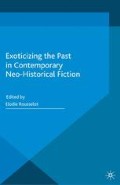Abstract
In her essay on the ethical responsibility of writers as ‘public intellectuals’, American author Cynthia Ozick declares, ‘history isn’t only what we inherit, safe and sound after the fact; it is also what we are ourselves obliged to endure’ (2000, p. 123). This statement certainly resonates with an observation of works by the current generation of Jewish writers who continue to grapple with the legacy of antisemitism, forced migrations, and the catastrophe of the Holocaust and its aftermath. The return to the Holocaust and pre-war period by Rebecca Goldstein, Michael Chabon, Nathan Englander, Thane Rosenbaum, Nicole Kraus, Jonathan Saffran Foer, and Nomi Eve (among others) perhaps reflects the history they are ‘obliged to endure’ as Jews and as writers in a post-Holocaust present. Yet, these works are less a representation of past trauma than an expression of the rupture with the past wrought by WWII that continues to haunt the present. It is as if the spectre of the Holocaust is always there, sitting at the table, hiding in a closet, ready to make its way onto the page. Finding the appropriate ways to register this ghostly presence is, not surprisingly, a central concern in a number of works that confront Holocaust issues.1
Access this chapter
Tax calculation will be finalised at checkout
Purchases are for personal use only
Preview
Unable to display preview. Download preview PDF.
Bibliography
Beckett, S. (2010) Waiting for Godot [1952] (London: Faber and Faber).
Behlman, L. (2004) ‘The Escapist: Fantasy, Folklore, and the Pleasures of the Comic Book in Recent Jewish American Holocaust Fiction’, Shofar: An Interdisciplinary Journal of Jewish Studies, 22(3), 56–71.
Bennington, G. (2013) ‘Psittacisms, or: Prolegomena to any Future Humanities That Will Be Able to Come Forward as Deconstruction’, http://www.academia.edu/221814/Psittacisms, 1–16, date accessed 2 June 2013.
Berger, A. (2010) ‘Michael Chabon’s The Amazing Adventures of Kavalier & Clay. The Return of the Golem’, Studies in American Jewish Literature, 29, 80–9.
Chabon, M. (2000) The Amazing Adventures of Kavalier & Clay: A Novel (New York: Picador).
Chabon, M. (2004) The Final Solution: A Story of Detection (New York: HarperCollins).
Cohen, J. J. (1996) ‘Monster Culture (Seven Theses)’ in J. J. Cohen (ed.) Monster Theory: Reading Culture (Minneapolis: University of Minnesota Press), pp. 3–25.
Curtius, E. (1876) ‘The Parrot of the Aturians’ in F. H. Hedley (trans.) Masterpieces of German Poetry (London: Trübner and Co), pp. 78–9.
Demetz, P. (2009) ‘Rabbi Loew and His Golem in German Literature’ in A. Putik (ed.) Path of Life: Rabbi Jud Loew Ben Bezalel ca. 1525–1609 (Prague: Jewish Museum in Prague), pp. 293–313.
Doyle, A. C. (1974) The Sign of Four [1890] (New York: Doubleday).
Doyle, A. C. (1996) The Final Problem [1893] in The Adventures and Memoirs of Sherlock Holmes (Ware: Wordsworth Editions), pp. 484–503.
Doyle, A. C. (2006) His Last Bow [1917] (London: Headline Review).
Dreifus, C. (1989) ‘Interview with Art Spiegelman’, The Progressive, 53(11), 34–7.
Frank, A. (1993) Anne Frank: The Diary of a Young Girl [1947] (New York: Bantam Books).
Gelbin, C. (2011) The Golem Returns: From German Romantic Literature to Global Jewish Culture, 1808–2008 (Ann Arbor: University of Michigan Press).
Gottheil, R., Strack, H., and Jacobs, J. (1906) ‘Blood Accusation’, The Jewish Encyclopedia, www.jewishencyclopedia.com, date accessed 10 January 2013.
Greenspan, H. (1998) “The Power and Limits of the Metaphor of Survivors’ Testimony’ in C. Schumacher (ed.) Staging the Holocaust: The Shoah in Drama and Performance (Cambridge and New York: Cambridge University Press), pp. 27–39.
Greenspan, H. (2011) “The Silver LiningM antra’, History of the Holocaust H-Net list-serve, 13 October, http://h-net.msu.edu/cgi-bin/logbrowse.pl?trx=vx&list=H-Holocaust&month=l 110&week=b&msg=N7FYgR90daIdhlSSWmllUA, date accessed 7 July 2013.
Hirsch, M. (2008) “The Generation of Postmemory’, Poetics Today, 29(1), 103–28.
Horowitz, S. R. (1997) Voicing the Void: Muteness and Memory in Holocaust Fiction (Albany: SUNY Press).
Klier, J., and Lambroza, S. (eds) (1992) Pogroms: Anti-Jewish Violence in Modern Russian History (Cambridge: Cambridge University Press).
Kohlke, M.-L., and Gutleben, C. (2010) ‘Introduction: Bearing After-Witness to the Nineteenth Century’ in M.-L. Kohlke and C. Gutleben (eds) Neo-Victorian Tropes of Trauma: The Politics of Bearing After-Witness to Nineteenth-Century Suffering (Amsterdam: Rodopi), pp. 1–34.
Lassner, P. (2011) ‘Race, Gender and the Holocaust: Traumatic Modernity, Traumatic Modernism’ in L. Pltt (ed.) Modernism and Race (Cambridge: Cambridge University Press), pp. 192–211.
Leviant, C. (ed. and trans.) (2007) ‘Introduction’ in Y. Rosenberg, The Golem and the Wondrous Deeds of the Maharal of Prague [1909] (New Haven and New York: Yale University Press), pp. xiii-xxv.
Morris, N. (2007) The Golem in Jewish American Literature: Risks and Responsibilities in the Fiction of Thane Rosenbaum, Nomi Eve and Steve Stern (New York: Peter Lang).
Myers, D. G. (2008) ‘Michael Chabon’s Imaginary Jews’, Sewanee Review, 116(4), 572–88.
Ozick, C. (2000) ‘Public Intellectuals’ in Quarrel and Quandary: Essays by Cynthia Ozick (New York: Knopf), pp. 120–6. von Humboldt, A., and Bonpland, A. (1827) Personal Narrative of Travels to the Equinoctial Regions of the New Continent during the Years 1799–1804, Vol. 5, H. M. Williams (trans.) (London: Longman, Rees, Orme, Brown, and Green).
Woolf, V. (1996) Mrs Dalloway [1925] (Ware: Wordsworth Editions).
Editor information
Editors and Affiliations
Copyright information
© 2014 Mia Spiro
About this chapter
Cite this chapter
Spiro, M. (2014). Beasts of Burdened Memories: Exotic Figures in Michael Chabon’s Neo-Historical Holocaust Fiction. In: Rousselot, E. (eds) Exoticizing the Past in Contemporary Neo-Historical Fiction. Palgrave Macmillan, London. https://doi.org/10.1057/9781137375209_10
Download citation
DOI: https://doi.org/10.1057/9781137375209_10
Publisher Name: Palgrave Macmillan, London
Print ISBN: 978-1-349-47724-1
Online ISBN: 978-1-137-37520-9
eBook Packages: Palgrave Literature CollectionLiterature, Cultural and Media Studies (R0)

